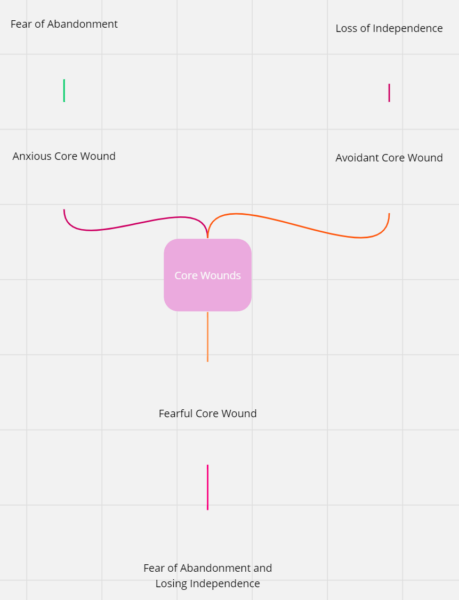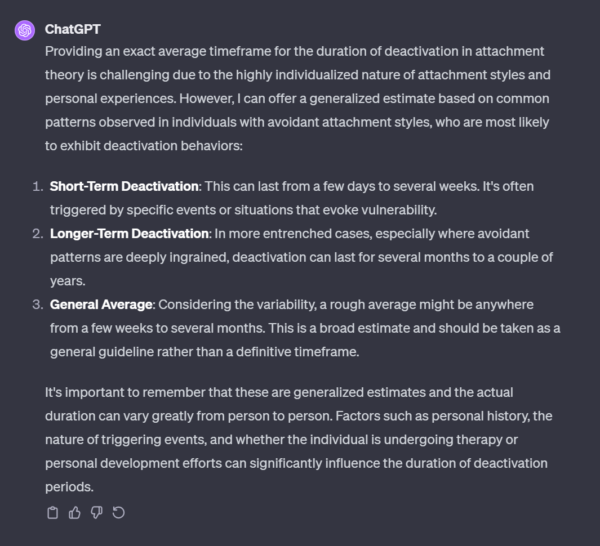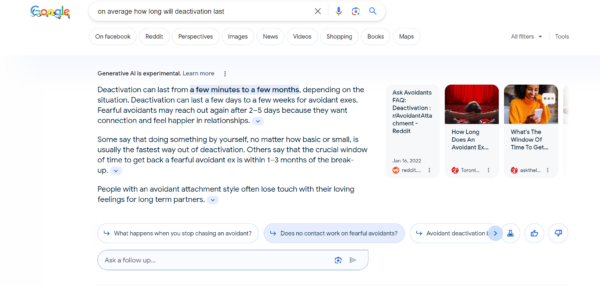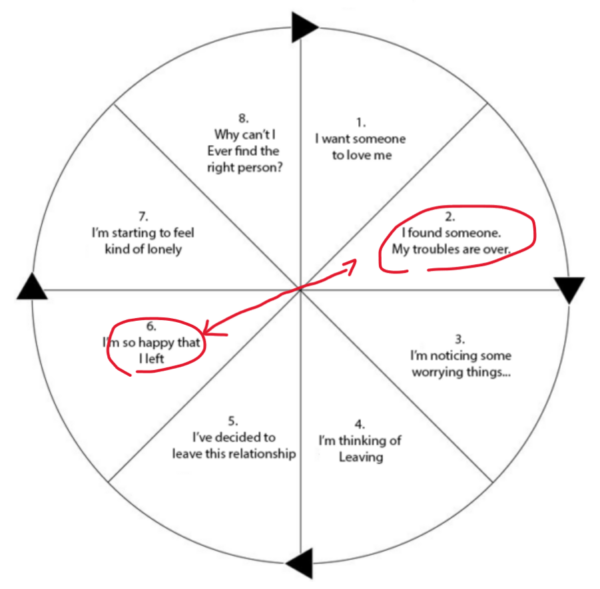Today we’re going to talk about how long avoidant deactivation tends to last.
In order to understand how long it’ll last you’ll need to take the general consensus of what everyone thinks, (usually around a few weeks to a few months) and combine it with where you are at in your specific relationship with your partner. There isn’t a “one size fits all” answer to this.
Doing that can give you an accurate accounting on how long you can expect an avoidants deactivation to go on for.
Honestly though, there’s a lot of nuance that’s required to fully grasp everything about this subject.
So, I’d like to take a look at,
- Avoidant deactivation
- Look at the redirection factor
- Understand what the consensus says about them
- And show you how you layer in your personal experience to get an idea of a time frame.
Let’s get started!

What Are Your Chances of Getting Your Ex Boyfriend Back?
Take the quizTaking A Look At Avoidant Deactivation
So, what the heck is deactivation?
Deactivation, in the context of psychological processes, can be understood as a protective mechanism of the mind. It’s not a prolonged emotional state, but rather an immediate response that the mind uses to shield itself, temporarily shutting down its attachment processes.
For an avoidant this almost always ties in to their core wound.
For those unfamiliar I always like to distill insecure attachment styles down to a singular core wound.

- Anxious = Fear of Abandonment
- Avoidant = Losing Independence
- Fearful = Both
Deactivation for avoidants is essentially something that happens as a protective mechanism to maintain their independence.
This isn’t something that lasts for weeks or months, but a reflexive action triggered by certain stimuli. For example, if a person with a dismissive-avoidant attachment (DA) is faced with a specific situation, they might permanently deactivate their attachment towards a partner in certain aspects of their relationship. This happens because the partner becomes neurologically linked with a past traumatic event that necessitates this shutdown for the individual’s safety.
Understanding deactivation is complex because it essentially turns off the individual’s ability to recognize their experiences as attachment-related.
The mind’s attachment system is effectively disabled.
Sometimes, people rationalize their deactivation, attributing it to seemingly unrelated or trivial reasons, or placing the blame on external factors (like saying they left because the other person was too emotional, claiming they don’t need needy people, or justifying it as needing to concentrate on work).
The Redirection Factor
A key sign of deactivation is redirection.
The distress that would typically be managed within the attachment system gets channeled into other areas like:
- Friendships
- Sexual relationships
- Professional life
- Societal norms.
These areas, while closely related to attachment, are not the same and serve as alternate channels for dealing with attachment-related distress.
Understanding Deactivation in Attachment
- Deactivation as a Defense Mechanism: In attachment theory, particularly in avoidant attachment styles, deactivation is a defense mechanism. It’s a way for individuals to suppress or avoid their attachment needs and feelings. This is often due to past experiences where seeking closeness or showing vulnerability led to rejection or discomfort.
- Triggering of Deactivation: Deactivation typically occurs in response to situations that would normally activate the attachment system – like emotional intimacy, vulnerability, or perceived threats of abandonment or closeness.
Implications of Redirection
- Avoidance of Core Issues: While these alternative channels might provide temporary relief or a sense of fulfillment, they often don’t address the underlying attachment-related distress. This can lead to a cycle where the core issues remain unresolved.
- Impact on Relationships: This redirection can impact the quality of relationships. For instance, an overemphasis on friendships or professional achievements might come at the cost of neglecting or avoiding deeper, more intimate relationships.
- Long-Term Consequences: Over time, this pattern can lead to a sense of disconnection or loneliness, as the deeper emotional needs related to attachment are not being met. It might also result in a pattern of unstable or superficial relationships.
But honestly the main flaw so far with this discussion is we haven’t really talked about how long they’ll deactivate for.
Well…
Here’s What The Consensus Says:
So, how long does deactivation typically last for an avoidant? Honestly it’s going to depend on a lot of different factors. Personally I’ve found that the more you try to cram human relationships into a “one size fits all” metric the worse the results tend to be.
So, the closest you can really come to answering this question is by coming up with a time frame.
And for that I went to three wildly different sources.
- I went to reddit and looked at what real people said (specifically this thread)
- Then I went to Chat GPT and looked at what it had to say (I know, I know… I sold out.)
- Then I went to Google’s Generative AI (which essentially scrapes its top results for the answer)
Here’s what each of them had to say.

What Are Your Chances of Getting Your Ex Boyfriend Back?
Take the quizWhat Real People On Reddit Say:

This person said that it varies and doesn’t consider pulling away for a day or two deactivating. They believe that deactivation essentially cuts off yoru attachment system and can last weeks/months/years.
(I’m not sure I agree with that but I’ll get into why later.)

This person says their significant other deactivates after big intimate moments and it’s usually only for a day. However, there’s a type of withdrawal period that comes after the deactivation that lasts weeks to months at its worst.
So, I think that withdrawal period is particularly interesting. Here we have another “weeks/months” vote.
What Chat GPT Said:

Chat GPT essentially hedged its bets and went with two time frames:
- Short term deactivation: A few days to several weeks
- Longer term deactivation: Several months to a couple of years
Chat GPT also came up with a general average,
A few weeks to several months.
Alrighty, another vote for the few weeks to several months bracket.
What Google’s Generative AI Says:

This one surprised me.
A few minutes to a few months. I’m actually not sure I agree at all with the “few minutes” bracket. I’ve never personally encountered this in my coaching. I’m not saying it can’t happen but I think it’s more on the rare side.
Putting It All Together
So, essentially here are what our three sources came up with:
- Reddit: A few weeks/months
- GPT: A few days/weeks/months/years
- Generative AI: A few minutes/months
It’s fluctuating all over the place and I think the reason revolves around a concept I alluded to earlier. There is no such thing as a “one size fits all” solution to this.
In fact, many of these sources failed to neglect the most important piece of the puzzle:
It Really Depends On Where You Are At In Your Relationship With Them
In my opinion, the duration of deactivation for an avoidant individual really depends on where you are in your relationship with them.
Think of it like this: throughout your life, as you are in relationships, you take deeper steps, forming bonds. Ideally, these bonds strengthen the relationship. However, an avoidant may perceive this bond as a direct threat to their independence.
Let’s consider four specific categories and stages of relationships to understand how long an avoidant is likely to last in them without deactivating.
By examining these stages, we can gain clear insight into why they deactivate and the typical duration of these periods.
- The Initial Dating Stage
- Post-Honeymoon Stage
- Cohabitation Stage
- Longer Term Commitment
Let’s dive in!
1. The Initial Dating Stage:
You’ve just started dating.

What Are Your Chances of Getting Your Ex Boyfriend Back?
Take the quizIf you’re familiar with my ‘Avoidant Death Wheel’ concept, you’ll recognize the importance of stages. T
he second stage, the honeymoon period, is usually trouble-free.

However, an avoidant might get slightly triggered during this time, perceiving even minor commitments as threats to their independence.
In this early stage, the deactivation period is generally short, lasting only a few days, as they don’t yet see you as a significant threat to their independence.
2. Post-Honeymoon Stage (6-7 months):
As the honeymoon period fades, the avoidant may become increasingly annoyed by any anxious energy from their partner.
In my coaching experience, this is a common phase where significant others begin to pull away, leading to a potential breakup.
During this stage, deactivation can last a few weeks, especially if the partner presses for closeness, which can exacerbate the avoidant’s withdrawal.
3. Cohabitation Stage:
Moving past the honeymoon phase, if the relationship hasn’t ended, and you’ve moved in together, this cohabitation can be seen as an infringement on the avoidant’s independence.
Deactivation periods tend to be longer here, and breakups can be more volatile.
4. Long-Term Commitment (Marriage):
Contrary to the assumption that avoidants never marry, they can end up in long-term commitments, especially if their partner is adept at reading their needs and respecting their space.
However, in such relationships, avoidants might experience prolonged deactivation periods, lasting months or even years. This is often due to a sunk cost fallacy; they don’t want to feel like their time has been wasted, yet they yearn for independence, leading to emotional disconnection.
So here’s the rub:
By analyzing these different commitment levels, we see a correlation between the relationship’s duration and the avoidant’s deactivation period. Rather than a one-size-fits-all answer, it’s important to consider both the general timeframe of a few weeks to a few months and the specific stage of your relationship.
Combining these factors provides a more accurate assessment of an avoidant’s deactivation duration.